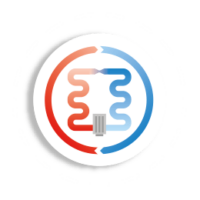Crolles (38920)
Type of project : Replacement
I am giving you a feedback on the MyDATEC RT 250H reversible thermodynamic ventilation system installed six months ago as a replacement for the double flow system. We were able to use it in cooling mode in the heat of the year, in ventilation only mode in mid-season and in heating mode in very cold periods.
Pre-existing facility and work motivation:
The house we live in was already equipped with a double flow ventilation system with a network of ducts integrated into the walls blowing air into the dry rooms and pumping it from the wet rooms. The ventilation system was out of order and located in the lost attic insulated with glass wool.
Six months ago, on the advice of a neighbor who was satisfied with his MyDATEC, we directly contacted the MyDATEC sales representative who advised us on the pump model and referred us to a partner installer: Sébastien Labat (LABATECO) located in Chambéry. On his advice, we had the glass wool replaced by cellulose wadding, which was done by the company KALEIDO located in Poisat near Grenoble.
The work lasted one week, and took place mainly in the attic. Thus, we were able to continue living in the house without being disturbed by the work, the dust produced being minimal since all the materials were passed through the roof.
Workflow:
After the removal of the glass wool by the Kaleido company, they agreed with Mr. Labat to install the technical floor that would allow circulation in the attic above the 35cm of cellulose wadding. The photo below shows the removal of the old pump: the glass wool having been removed, the old ducts could be changed. The installation of the floor then begins in order to facilitate the maintenance of the future system.
The new network of insulated ducts could be installed on the joists in order to be buried under the cellulose wadding to minimize heat loss in the attic.
We notice on the photo a motorized shutter which allows to draw the new air either in front or in the attic for the winter. This air is supplied through large diameter ducts to the
pump. The stale air is extracted from the house by the pump and expelled through the chimney flue seen in the background of the picture. Once the ducts were installed, the Kaleido company proceeded to blow in the cellulose wadding that covered the ducts.
Once distributed, the 35cm of wadding are flush with the technical floor which allows circulation in the attic. At the end of the installation of the wadding, a film of water is projected on the surface to make it crust and stabilize it in prevention of the draughts of the roofs.
Pump Maintenance:
During the six months of use, when the pump was able to operate in both cooling and heating mode, no problems were noticed. The pump was hung near the attic access hatch, which allows easy access to the filter drawers (in black at the top of the photo). Mr. Labat preventively added a third trap to the two existing ones in the pump on the condensate path to the toilet vent to avoid any odor return in the air circuit. On the picture below, you can see a grey PVC tube at the entrance of the attic which allows to control the good flow of these condensates. I haven’t noticed any problems with this yet.
After six months, the cellulose wadding has not settled and it does not fly thanks to its surface crust. I just notice some traces of animals on its surface, certainly rodents that came in through the attic vents. There is obviously no nest and the pump and its ductwork remain intact.
Comfort after six months of operation:
In summer mode (cooling), the system brings a very appreciable comfort. Without trying to lower the temperature of the house too much, the entry of fresh air in the house brings a feeling of freshness. This system is also very appreciable at night to cool the house without opening the windows and being victim of mosquitoes…
As for the winter mode (heating), the system is remarkable:
1. The attic air intake not only tempers the incoming air but also diffuses the air intake to limit the entry of smoke from chimneys of houses in the neighborhood. Certainly thanks to the crust on the surface of the cellulose wadding, I did not notice any dust entering through the air inlets.
2. Even with sub-zero outside temperatures, the air blown into the house is tempered, the pump worked without a hitch while a neighbor who had an outdoor thermodynamic unit did three defrost cycles in the night. Indeed, his system draws calories from outside, and because it was too cold, his pump froze. This is not possible with the MyDATEC thermodynamic CMV since the source of calories comes from the air extracted from the house by the CMV. Thus, the temperature of the energy source is constant and the pump’s efficiency is also constant!
There is absolutely no noise from the rooms when the pump is running. A very slight humming sound can be heard at night under the attic access hatch when the compressor is running. The air inlets and outlets are absolutely silent in the winter, and only the kitchen exhaust air outlet emits a slight murmur in the summer when the pump is running in cooling mode. The rest of the time, the air renewal at 250m3/hour is done without noise and without any sensation of air circulation!
In conclusion, I would say that I am not only pleased with this installation, but also impressed with the technology. To be healthy, a house must be ventilated. However, without a special device, the warm air that comes out is lost and the air that replaces it is cold and cools the house. With this system, the calories of the air leaving the house are recovered and transferred to the air coming in. The house is then well ventilated without being cooled, it does not smell musty, the air which enters seems healthy and without particular odor.
Our chimney is enough to compensate for the cold radiation from the windows.
Finally, thanks to the double flow, the chimney has no draught problems and there is no smoke return in the house.
Marc *********



